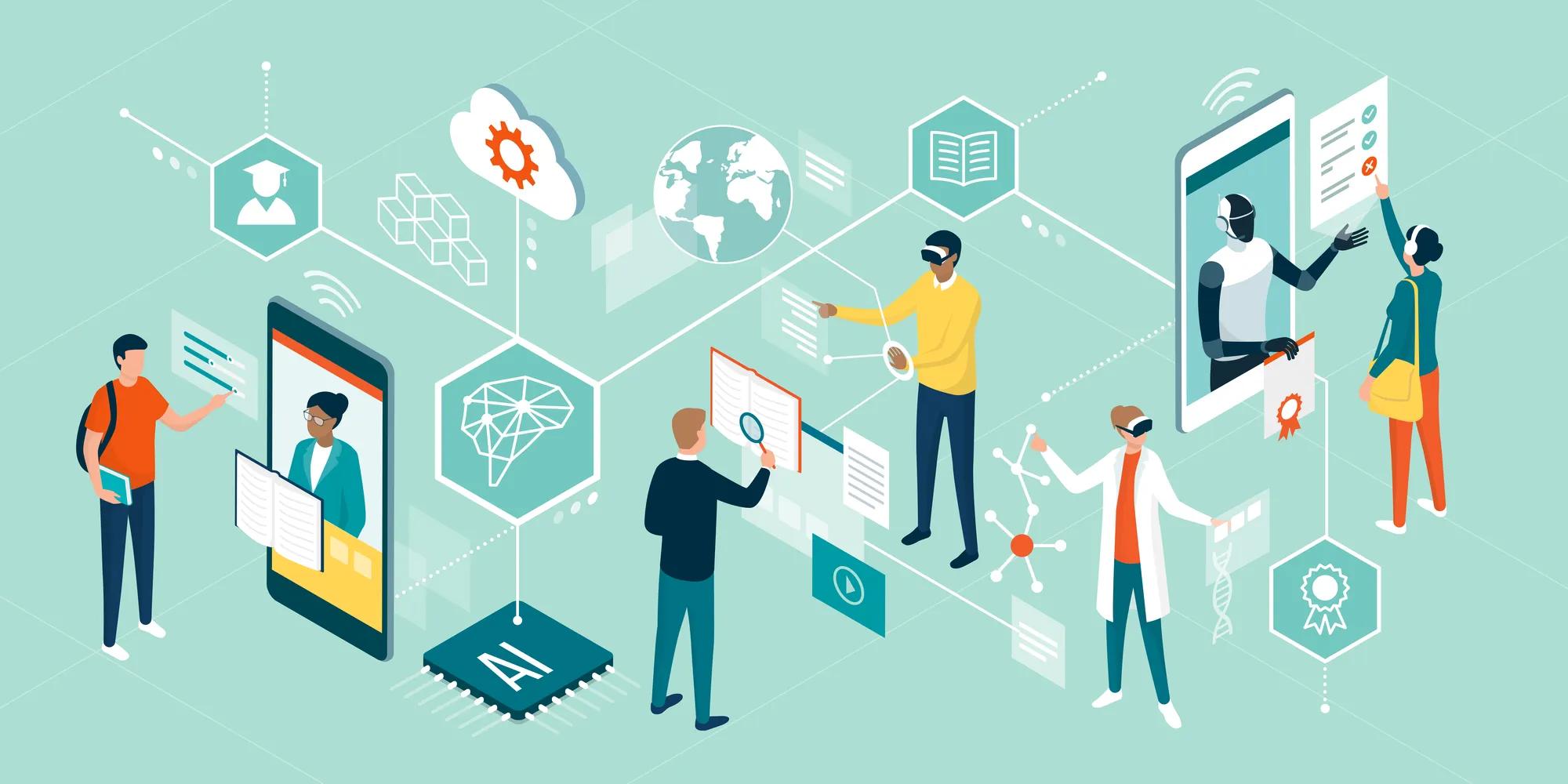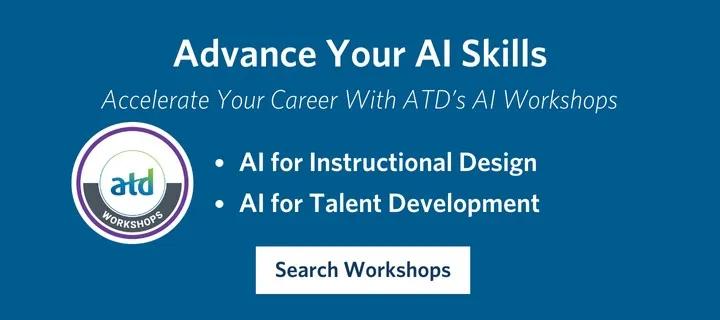ATD Blog
AI Is Advancing Faster Than Your Workplace Training: What You Can Do to Bridge the Gap
Fueled by an AI-integrated learning ecosystem, course designers and trainers can stay one step ahead.
Wed Apr 02 2025

Bookmark
Streamlining ad-hoc tasks, informing data-driven decision making, and driving innovation, AI has the potential to level up workplaces. But—here’s the sticking point—its potential is limited to how well employees can use it.
Simply put, AI training is key to optimizing generative tech in the workplace. Yet, TalentLMS L&D benchmarking research reveals a stumbling block. Almost half of employees (49 percent) say AI is advancing faster than their company’s learning and development programs are keeping up.
It’s a tough gig for L&D professionals. But not insurmountable with the right strategies up your sleeve. By rethinking key elements of the delivery, design, and detail of training, it’s possible to tackle the challenge head-on. And win.
Delivery: Roll Out Training Faster
Quick-fire developments require a quick-fire response. AI is expected to take on 70 percent of text- and data-heavy tasks this year. And 92 percent of companies plan to increase AI investments over the next three years. But only 1 percent of leaders say AI is fully deployed and delivering a tangible ROI. This highlights a major skills gap—one that can’t be addressed with slow-moving training methods. Waiting months, or longer, for static e-learning modules to be designed or updated isn’t an option with AI upskilling. Neither are traditional training programs based around annual conferences, pre-booked workshops, or printed manuals or handbooks. So, what’s the answer?
How do you bridge the gap?
To keep up with AI developments, 69 percent of employees TalentLMS surveyed cite the importance of faster delivery of new employee training programs. Generally speaking, this means leveraging digital training solutions that allow for quick updates, continuous learning, and on-demand access. Specifically, it breaks down into the following tactics:
Make microlearning mainstream. Bite-size content is easier to update. It also allows learners to consume training quickly and frequently.
Leverage adaptive learning platforms. By employing an LMS with AI integration, learning can be personalized and based on timely skill needs. Content can also be updated in real time based on emerging trends.
Use an AI course creator to roll out new training programs quickly.
Take advantage of ready-made training courses designed by third-party providers.
Host regular live webinars and/or virtual instructor-led training (VILT) sessions focused on new AI developments.
Deploy AI chatbots and virtual assistants for just-in-time learning and support. Be ready to max out on AI agents when they become more mainstream.
Promote discussion forums and internal collaboration channels. These can be used to share the latest AI news, tools, and best practices.
Align training with jobs to support the speedy application of AI developments into the flow of work.
Alert employees to new training modules using push notifications powered by an LMS.
Detail: Provide Clarity and Support
Will AI steal my job? How might my role change? What kind of tasks could it help with? A personal fear of the unknown played a big role in most employees’ early perceptions of AI in the workplace. As did broader concerns around ethics and governance. Bias, misinformation, and data privacy all quickly emerged as issues employees had to consider when using generative tech.
Despite this, 54 percent of employees TalentLMS surveyed say their companies have, to date, failed to provide guidelines on using AI tools. And 65 percent are still waiting for training on how to use AI safely and ethically.
How do you bridge the gap?
To keep AI training dynamic and progressive (and the uptake high) means offering reassurance, providing clarity, and demonstrating relevance. This translates to AI training that focuses on practical application as well as ethical use—and is supported by clear responsible usage policies and comprehensive general guidance. Underpinned by these safety nets, employees can understand firsthand how to integrate AI into their daily work while remaining safe and compliant. Plus, with a strong guiding hand, they have the confidence to put training into practice and let AI do the heavy lifting. Not only does this boost productivity, but it helps to wipe out inconsistencies and inefficiencies too.
Don’t forget to be open and transparent about the scale and scope of your AI L&D provision, either. Twenty-three percent of employees hesitate to ask for additional training because the budget availability is unclear. So, if you’ve got the resources to provide extra learning opportunities, don’t let it go to waste. Make sure your employees know about it.
Design: Go Soft on Skills
To optimize the benefits of AI training, employees need more than technical know-how. They need to know how to apply AI tools thoughtfully, artfully, and strategically. Yes, AI can automate tasks, but it can’t replace human judgment, creativity, and emotional intelligence. Mindful of this, it’s perhaps no surprise that employees rank soft skills training among the top three training priorities for 2025.
How do you bridge the gap?
This is a strong action point for L&D professionals. AI training needs to be balanced with soft skills development to ensure AI is used effectively in the workplace—and to help drive business success. But what, specifically, should training teams focus on? Here are the soft skills you’ll need to cultivate to drive success in an AI-driven landscape:
Critical thinking and problem-solving: AI can analyze data, but employees must interpret insights, question outputs, and make informed decisions.
Adaptability and continuous learning: Since AI evolves rapidly, employees need a growth mindset to keep pace with new tools and changing workflows.
Empathy and emotional intelligence: As AI propels ongoing change in the workplace, employees who can demonstrate understanding and sensitivity among their peers will be in high demand.
Collaboration: AI tools can enhance productivity, but they can’t cultivate meaningful and productive interpersonal relationships. Or compete with the power of effective teamwork to spark innovation and provide inspiration.
Communication: In a digital-first world, employees need the skills to articulate AI-driven insights to stakeholders. And explain complex concepts in simple, actionable ways.
Part of the Solution
To a greater or lesser extent, AI forced itself on businesses—whether they liked it or not. Raw and uncut, it elbowed its way into workflows. And raised questions that most organizations weren’t yet ready to answer. Starting the clock and setting the agenda, it may not have been the easiest start to a relationship. But it quickly earned its place on the team, becoming more friend than foe.
The same applies to AI training. The pace at which AI is advancing presents a challenge for L&D teams. But it also presents a big part of the solution. The more generative tech evolves, the better equipped it is to help training professionals deliver targeted, development opportunities at speed.
Fueled by an AI-integrated learning ecosystem, course designers and trainers can stay one step ahead. They can predict future skills needs and adapt training accordingly. And provide in-the-moment learning that propels AI into the forefront of day-to-day operations.


